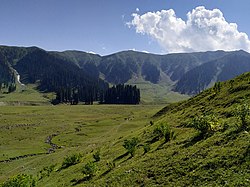Kupwara district Kopwor | |
|---|---|
 Bangus Valley in Kupwara | |
 Interactive map of Kupwara district | |
 Kupwara district is in Indian-administered Jammu and Kashmir in the disputed Kashmir region [1] It is in the Kashmir division (bordered in neon blue). | |
| Coordinates(Kupwara): 34°37′N74°13′E / 34.617°N 74.217°E | |
| Administering country | India |
| Union Territory | Jammu and Kashmir |
| Division | Kashmir Division |
| Established | 1979 |
| Headquarters | Kupwara |
| Government | |
| • Lok Sabha Constituency | Baramulla |
| • MP [2] | Engineer Rashid |
| • Vidhan Sabha Constituencies | 6 : Karnah, Trehgam, Kupwara, Lolab, Handwara and Langate |
| Area | |
• Total | 2,379 km2 (919 sq mi) |
| • Urban | 47.3 km2 (18.3 sq mi) |
| • Rural | 2,331.7 km2 (900.3 sq mi) |
| Population | |
• Total | 870,354 |
| • Density | 365.8/km2 (947.5/sq mi) |
| • Urban | 104,729 |
| • Rural | 765,625 |
| Demographics | |
| • Literacy [6] | 64.51% |
| • Sex ratio [6] | 835 ♀/ 1000 ♂ |
| Languages | |
| • Official | Kashmiri, Urdu, Hindi, Dogri, English |
| Time zone | UTC+05:30 (IST) |
| Vehicle registration | JK-09 |
| Major highways | |
| Website | kupwara |
Kupwara district is an administrative district of Indian-administered Jammu and Kashmir in the disputed Kashmir region. [1] It is one of the 10 districts located in the Kashmir Valley Division of Indian administered Kashmir. The Pohru River (originating in Lolab Valley and flowing from east to west) and Mawar river are two main rivers in the district. Both of them meet Jhelum river in Baramulla district. [9]
